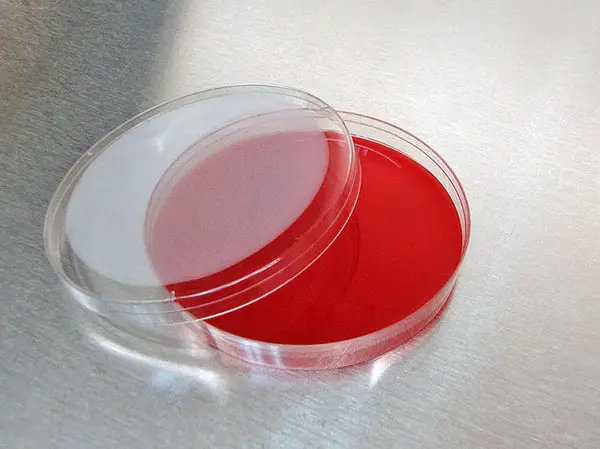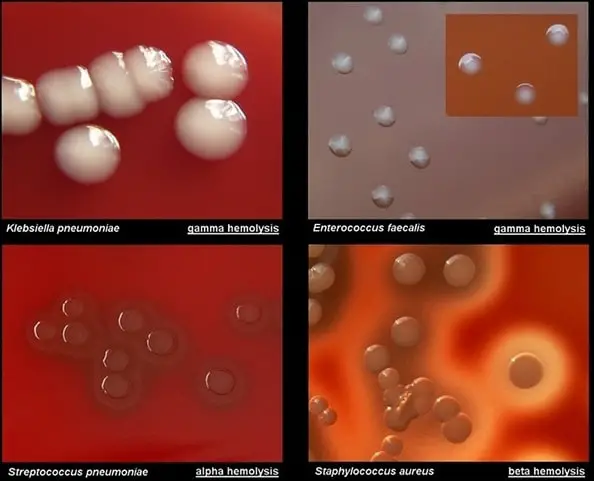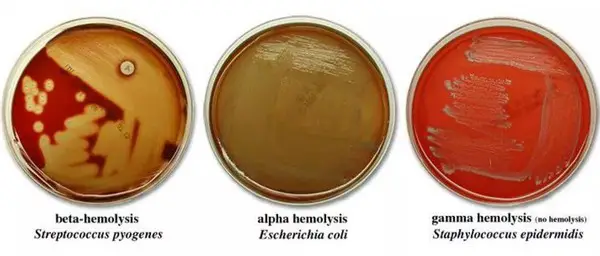Blood agar is a type of bacterial growth medium. It is primarily used to grow fastidious microorganisms like Streptococci. Such organisms do not grow well using ordinary growth medium.
They only grow in blood agar because such medium has inhibitors for some family of bacteria. The medium needs to be heated to inactivate the inhibitor and release a specific growth factor. Once blood agar is heated, it will be converted into chocolate agar. (1, 2)

Picture 1: The Petri plate contains a blood agar medium.
Image Source: microbeonline.com

Picture 2: A blood agar containing 5% of sheep blood.
Image Source: emp.com.ge
Examples of bacteria that grow on blood agar medium
- Haemophilus influenza
- Neisseria species
- Streptococcus pneumonia
Blood agar as a differential medium
Blood agar is a differential medium because it helps detect and differentiate haemolytic bacteria such as Streptococcus species. It detects hemolysis by cytolytic toxins that are secreted by some strain of bacteria. (1, 2, and 3)
Blood agar as a selective medium
Blood agar can be used as a selective medium for some types of pathogens. For it to be selective, a chemical, dye, or antibiotic should be added to it. (4)
Blood agar Components
- Agar
- Pancreatic digest of casein
- Sodium chloride
- Papaic digest of soy meal
- Beef extract
- Peptone
- Sheep blood, defibrinated
- Distilled water
- pH 7.3 ± 0.2 at 25°C
Blood agar Preparation
- Prepare the base as per the manufacturer’s instruction.
- Autoclave for about 15 minutes at 121 degree Celsius.
- Transfer the blood agar base to the water bath at a temperature of 50°C.
- Once the base has cooled down, start adding sterile blood agar (5% of defibrinated blood) and mix well to prevent the formation of air bubbles.
- Dispense about 15 ml to a sterile petri plate.
- Store the plate at 2 to 8 degree Celsius in a sealed plastic bag.
- Make sure you prevent moisture loss for the blood agar to last for up to four weeks. (3, 4, 5, and 6)
What is blood agar used for?
- It is used to isolate and identify antimicrobial susceptibility of Streptococci.
- It is used to isolate and cultivate Streptococci, Neisseria, and fastidious microorganisms.
- Blood agar helps differentiate bacteria based on their haemolytic properties.
- It is used to prepare Salmonella typhi antigens.
- It determines the salinity range of marine Flavobacteria.
- Blood agar base can be used for testing food samples as per the recommendation of APHA.
- It helps determine the type of hemolysis. (6, 7)

Picture 3: A blood agar showing different kinds of hemolysis and the bacteria strain that grows in it.
Image Source: microbiologyinfo.com

Picture 4: Three petri plates with different types of hemolysis.
Image Source: orbitbiotech.com
Blood Agar and Hemolysis
Some species of bacteria produce extracellular enzymes which have the ability to lyse red blood cells in the blood agar. The extracellular enzymes is called hemolysins. It has the ability to destroy cells and release the red component of the blood (hemoglobin) into the medium.
The red color of hemoglobin is altered as it is exposed to the chemicals in the blood agar. (2, 4, and 5)
How to determine hemolysis?
To find out if hemolysis has taken place, you should streak for isolation on the blood agar plate. The medium is incubated overnight and will be inspected for any signs of hemolysis.
If the color of the medium is altered as characterized by a dark or discolored medium, it means that the organism has undergone alpha-hemolysis. On the other hand, the hemolysis is beta-hemolytic if the medium is cleared under growth. If the color of the medium didn’t change, it means that the medium constitutes gamma-hemolysis. (8, 9, and 10)
Haemolytic activities categorized into three types
- Beta-hemolysis – Clear medium
- Alpha-hemolysis – Dark or discolored medium
- Gamma- hemolysis – No changes in the medium (5, 7, and 8)
Are blood agar plates selective or differential?
Blood agar is both a selective and a differential medium. It helps detect Streptococcus pyogenes and at the same time helps differentiate the type of hemolysis produced such as alpha-hemolysis, beta-hemolysis, and gamma-hemolysis.
What Bacteria grow on blood agar?
- Neisseria
- Haemophilus genera
- Streptococcus pyogenes
- S. pneumonia
- Satellitism of H. influenza
- Streptococcus pneumonia
- Streptococci-Streptococcus agalactiace
- Clostridium perfringens
What is the difference between blood agar and chocolate agar?
Blood agar and chocolate agar are quite similar but they differ in preparation. Blood agar consists of many ingredients but the primary ingredient is the blood, which came from a rabbit or a sheep.
It is treated and water and a number of other ingredients are added to sterilize the solution. The blood is treated to remove fibrin, the clotting factor of the blood. On the other hand, chocolate agar contains lysed red blood cells, which turns brown giving the medium its chocolate color. (3, 6, 9, and 10)
References
- https://microbeonline.com/blood-agar-composition-preparation-uses-and-types-of-hemolysis/
- https://en.wikipedia.org/wiki/Agar_plate
- http://www.austincc.edu/microbugz/blood_agar_test.php
- https://microbiologyinfo.com/blood-agar-composition-preparation-uses-and-pictures/
- http://www.asmscience.org/content/education/protocol/protocol.2885
- https://www.biosciencetimes.com/microbiology/blood-agar-composition-principle-preparation-uses/180/
- http://spot.pcc.edu/~jvolpe/b/bi234/lab/differentialMedia/bloodAgarPlates.htm
- https://sciencing.com/nutrient-agar-vs-blood-agar-6372699.html
- http://www.vumicro.com/vumie/help/VUMICRO/Blood_Agar.htm
- https://catalog.hardydiagnostics.com/cp_prod/Content/hugo/BloodAgar.htm
